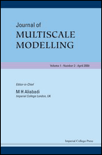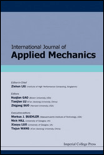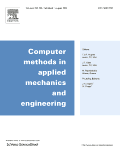
JOURNAL OF THERMAL STRESSES
Scope & Guideline
Pioneering Research in Condensed Matter Physics
Introduction
Aims and Scopes
- Thermoelasticity and Thermal Stress Analysis:
The journal extensively covers the study of thermal stresses and their effects on materials and structures, including the development of analytical and numerical models to predict behavior under thermal loading. - Advanced Material Behavior:
Research on the thermomechanical properties of advanced materials, including functionally graded materials, nanocomposites, and biomaterials, is a key focus area, emphasizing their unique responses to thermal loads. - Multiphysics and Multiscale Modeling:
The journal promotes studies that integrate various physical phenomena, such as thermal, mechanical, electrical, and magnetic interactions, often at multiple scales, to provide a comprehensive understanding of material behavior. - Innovative Computational Techniques:
It highlights the use of cutting-edge computational methods, such as finite element analysis, meshfree methods, and machine learning algorithms, to solve complex thermomechanical problems. - Experimental Validation and Application:
The journal encourages the publication of experimental studies that validate theoretical models and computational predictions, emphasizing real-world applications in engineering and materials science.
Trending and Emerging
- Functionally Graded and Composite Materials:
There is a growing emphasis on the analysis and modeling of functionally graded materials and composites, which are increasingly used in engineering applications due to their tailored properties. - Nanomaterials and Microstructural Effects:
Research focusing on the thermomechanical behavior of nanomaterials and the influence of microstructural features is on the rise, highlighting the unique properties and challenges at the nanoscale. - Machine Learning and AI in Thermomechanics:
The integration of artificial intelligence and machine learning techniques in the analysis of thermal stresses is emerging, facilitating predictive modeling and optimization in complex systems. - Bio-thermoelasticity:
The study of thermal stresses in biological tissues and materials is gaining prominence, driven by applications in biomedical engineering and the need for understanding the behavior of biological systems under thermal loads. - Dynamic and Transient Thermal Analysis:
There is an increasing focus on dynamic thermal responses and transient analysis, addressing real-time behavior of materials under varying thermal conditions, which is crucial for many industrial applications.
Declining or Waning
- Traditional Thermoelastic Models:
Research focusing solely on classical thermoelasticity without integration of modern techniques or multiphysics approaches has decreased, as more complex modeling frameworks gain traction. - Basic Heat Transfer Studies:
Studies that merely address fundamental heat transfer mechanisms without considering coupled effects or advanced materials are becoming less prevalent, as the focus shifts towards more interdisciplinary approaches. - Static Analysis of Simple Geometries:
The publication of works dealing with static thermal stress analysis in simple geometries has waned, reflecting a trend towards more complex and realistic scenarios that incorporate dynamic loading and intricate geometries.
Similar Journals

Frattura ed Integrita Strutturale-Fracture and Structural Integrity
Illuminating the Path to Enhanced Material PerformanceFrattura ed Integrita Strutturale - Fracture and Structural Integrity is a prominent open-access journal published by GRUPPO ITALIANO FRATTURA since 2007, dedicated to advancing the fields of Civil and Structural Engineering, Mechanical Engineering, and Mechanics of Materials. With an E-ISSN of 1971-8993, this journal has established itself as a significant platform for researchers and practitioners in the engineering community, offering an accessible outlet for high-quality research and innovative methodologies. The journal has achieved impressive standings in the Scopus ranks, notably being positioned in the second quartile (Q2) across its relevant categories in 2023, indicating its growing influence and the quality of the research it disseminates. With a publishing scope extending from 2011 to 2024, Frattura ed Integrita Strutturale continues to be an invaluable resource for addressing the mechanics of material integrity and fracture phenomena, inviting contributions that advance understanding and foster multidisciplinary dialogue. By prioritizing open access, the journal ensures that vital research is readily available to a global audience, enhancing collaboration and knowledge sharing among academia and industry alike.

STRENGTH OF MATERIALS
Bridging theory and practice in material mechanics.STRENGTH OF MATERIALS is a prestigious journal published by SPRINGER that focuses on the critical field of mechanics of materials, providing an authoritative platform for the dissemination of research and developments in material strength analysis since 1969. With an ISSN of 0039-2316 and an E-ISSN of 1573-9325, this journal serves a global audience of researchers, professionals, and students, contributing essential insights into the physical properties and performance characteristics of various materials under stress and strain. As part of the United States' academic literature, it showcases work that not only advances theoretical knowledge but also applies to practical engineering scenarios. Although ranked in the Q4 tier with respect to its category in Mechanics of Materials, with a Scopus rank of #319 out of 398 (19th percentile), it remains an important resource for those looking to expand their understanding in this specialized area. Researchers can access a wealth of information through this journal, fostering continued innovation and interdisciplinary collaboration.

FINITE ELEMENTS IN ANALYSIS AND DESIGN
Transforming analysis into design excellence.FINITE ELEMENTS IN ANALYSIS AND DESIGN, published by Elsevier, is a leading international journal dedicated to advancing the field of engineering analysis using finite element techniques. With a strong focus on theoretical and applied contributions, the journal spans a broad spectrum of subjects, including structural analysis, computational mechanics, and computer graphics applications, making it an essential resource for researchers, professionals, and students alike. As evidenced by its impressive Q1 ranking in multiple categories, including Analysis and Computer Graphics, and its Scopus rankings placing it in the top 10% across several fields, it serves as a vital platform for disseminating cutting-edge research and innovative applications within the field. The journal, with an ISSN of 0168-874X and an E-ISSN of 1872-6925, publishes articles that emphasize rigorous mathematical methodologies and computational advancements, ensuring high relevance for contemporary engineering challenges. With a history extending from 1985 to 2024, it continues to shape the discourse and progress within the finite element community.

Journal of Multiscale Modelling
Fostering Collaboration in Multiscale ResearchWelcome to the Journal of Multiscale Modelling, a reputable publication dedicated to advancing the fields of Modeling and Simulation and Computer Science Applications. Published by World Scientific Publishing Co Pte Ltd in Singapore, this journal serves as a vital resource for researchers, professionals, and students seeking to explore the intricate relationships between various scales of modeling systems. Since its inception in 2009, the journal has established a pivotal role within the academic community, evidenced by its Q4 ranking in both its respective categories and its interests in contributing to the understanding of complex systems through innovative simulation techniques. With an ISSN of 1756-9737 and an E-ISSN of 1756-9745, the journal encourages submissions that push the boundaries of current knowledge and methodologies. Though currently not open access, articles published in this journal are recognized for their scholarly rigor and innovation, aiming to foster collaboration across disciplines and enhance the practical applications of multiscale modeling techniques in various industries. Join us in exploring the vast potentials of multiscale modeling that lie ahead.

Extreme Mechanics Letters
Connecting Scholars with Cutting-Edge DiscoveriesExtreme Mechanics Letters is a distinguished scholarly journal published by Elsevier, focusing on advanced insights in the realms of bioengineering, mechanical engineering, chemical engineering, and mechanics of materials. With an impressive Q1 ranking in multiple categories and a strong representation in Scopus, this journal serves as a vital platform for researchers aiming to disseminate pioneering findings in extreme mechanics. Since its inception in 2014, the journal has rapidly established itself as a leading publication within its field, attracting high-quality manuscripts that push the boundaries of current understanding. As an important resource for professionals and scholars alike, Extreme Mechanics Letters provides valuable insights critical for driving innovation in engineering disciplines. While the journal currently operates on a subscription-based access model, it remains committed to fostering scholarly communication across the globe, ensuring that cutting-edge research reaches its intended audience.

International Journal of Mechanics and Materials in Design
Advancing the Frontiers of Mechanics and Material DesignInternational Journal of Mechanics and Materials in Design is a leading publication in the field of mechanical engineering and materials science, published by Springer Heidelberg. With an impressive impact factor, it holds esteemed rankings as Q1 in both Mechanical Engineering and Mechanics of Materials, and Q2 in Materials Science for the year 2023, solidifying its reputation as a significant contributor to the advancement of design methodologies. The journal focuses on the intersection of mechanics and materials, encouraging innovative research that addresses contemporary challenges faced in engineering disciplines. Researchers and professionals alike can benefit from accessing cutting-edge studies contributing to various applications, making it an invaluable resource for staying informed in this dynamic field. While the journal operates under a subscription model, its comprehensive reviews and high-quality original research foster a deeper understanding of material behavior and design principles, thus supporting the academic growth and professional development of its readers.

ENGINEERING FRACTURE MECHANICS
Shaping the Future of Engineering through Fracture StudiesENGINEERING FRACTURE MECHANICS, published by Pergamon-Elsevier Science Ltd, is a leading peer-reviewed journal that specializes in the field of fracture mechanics, focusing on the behavior of materials under stress. Established in 1968 and continuing to publish valuable research through 2024, this journal is pivotal for advancing the understanding of fracture mechanisms and their implications across various engineering disciplines. With its impressive impact factor and ranked in the Q1 category for Materials Science, Mechanical Engineering, and Mechanics of Materials, it holds a distinguished position in the academic community, reflected in its high Scopus rankings. Although the journal does not offer Open Access, it provides a wealth of knowledge and insights critical for researchers, professionals, and students aiming to deepen their expertise in the mechanics of materials and innovative engineering solutions.

International Journal of Applied Mechanics
Advancing the Frontiers of Applied MechanicsThe International Journal of Applied Mechanics, published by World Scientific Publishing Co Pte Ltd, is a premier platform that serves the fields of materials science, mechanical engineering, and mechanics of materials. Located in Singapore, this journal has established itself as a crucial resource for researchers, professionals, and students, with its convergence of scholarly work from 2009 to 2024. Ranked in the Q2 category across notable disciplines, including Materials Science, Mechanical Engineering, and Mechanics of Materials, it reflects a strong commitment to publishing high-quality research that pushes the boundaries of knowledge in applied mechanics. Despite being a non-open access journal, its successful Scopus rankings, including an impressive rank of #151 in Mechanical Engineering, signify its substantial impact and recognition within the academic community. This journal not only aims to disseminate pioneering research but also to foster collaboration and innovation in the rapidly evolving landscape of applied mechanics.

COMPUTER METHODS IN APPLIED MECHANICS AND ENGINEERING
Leading the Charge in Computational Mechanics Excellence.COMPUTER METHODS IN APPLIED MECHANICS AND ENGINEERING, published by Elsevier Science SA, is a premier journal that has significantly contributed to the fields of computational mechanics, computer science applications, mechanical engineering, and the mechanics of materials since its inception in 1972. With an ISSN of 0045-7825 and an E-ISSN of 1879-2138, this journal is recognized for its rigorous peer-review process and is consistently ranked in the Q1 quartile across multiple categories, including Computational Mechanics and Mechanical Engineering. Its impressive Scopus rankings place it in the top tiers of its field, with a percentile ranking of 98th in Computational Mechanics. Researchers, professionals, and students will find the journal's comprehensive scope and high-quality articles invaluable for advancing their knowledge and practices at the intersection of engineering and computation. Although not an open-access journal, its impactful contributions to both theoretical and applied research make it an essential resource for anyone involved in these dynamic fields.

ACI STRUCTURAL JOURNAL
Bridging Theory and Practice in Structural EngineeringThe ACI Structural Journal, published by the American Concrete Institute, serves as a premier platform for scholarly articles and research findings in the fields of building and construction and civil and structural engineering. With a commitment to advancing concrete technology and its applications, this journal has amassed an impressive reputation, holding a Q2 ranking in both Building and Construction and Civil and Structural Engineering categories as of 2023. The journal’s focus on innovative research and practical applications enables professionals, researchers, and students to stay at the forefront of industry developments. Although it does not offer open access, the content bears significant impact, ensuring that readers engage with high-quality research. As the journal converges its years of publication from 1987 to 2024, it continues to enrich the academic and professional discussions surrounding structural engineering and concrete science.